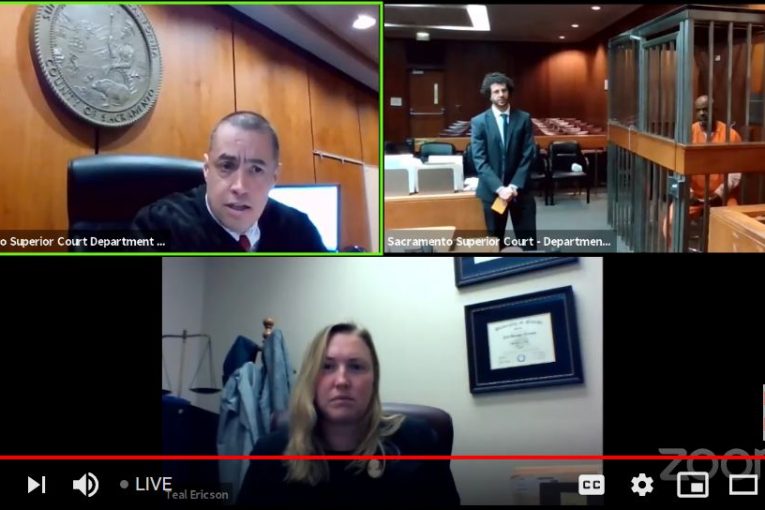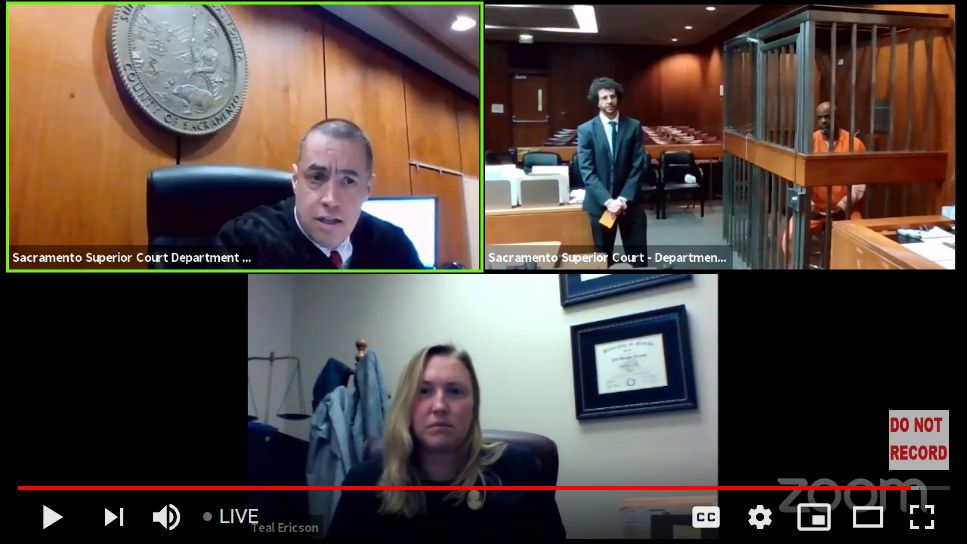

By Crescenzo Vellucci
Vanguard Sacramento Bureau Chief
SACRAMENTO – Not one, but several Sacramento Superior Court judges this week acknowledged “that 150-page motion” – it’s actually “only” 144 pages with exhibits – the Sacramento County Public Defender Office produced to argue the Sacramento County District Attorney plea to nullify the State Judicial Council’s COVID-19 emergency order to release county jail inmates is “insufficient.”
The Judicial Council unanimously approved the emergency order last week to reduce the number of bodies in the state’s local jails and minimize the threat of COVID-19 hot spots on vulnerable incarcerated populations – it mandated that bail for most of the jail detainees, with some exceptions, should be reduced to zero.
As a result, hundreds of people in Sacramento County’s two jails expected to get out Monday. But that’s not what happened. The DA has challenged 103 of about 309 people who were to be let loose – the DA said those particular inmates pose a “public safety” threat on the streets, although prison reform advocates have argued that plenty of “dangerous” criminals who had the money to pay high bail are already loose.
So far this week, in Zoom live streamed hearings – some longer than others – a majority of the DA’s objections have been overruled by several judges and detainees released. But the week’s not over.
And the judges, while they all said they’ve read the pleading by the PD, seem to be taking each case individually on its own merits.
Still, the inmate population was been trimmed even before this week. It’s around 2,600 detainees, down from a high of about 4,000. This new release would bring the jail population closer to the 2,300 level.
And that was the point of the Judicial Council’s edict – to reduce jail count so it lessens the chance of a COVID-19 outbreak…smaller numbers mean remaining inmates could more easily “socially-distance.”
Writing to the court, Assistant Public Defender John Stoller said:
“Some of the offenses articulated by the prosecution might qualify for a no-bail finding; however, the prosecutor’s attachment is insufficient to make that determination for over 70% of the listed offenses…Moreover, mere assertions of ‘public safety’ are an insufficient offer of proof to trigger the hearing. This court should reject the prosecution’s objection and set bail as required by the  Emergency Mandatory Bail Schedule for all qualifying cases.”
Emergency Mandatory Bail Schedule for all qualifying cases.”
He specifically noted three reasons why the DA is wrong to oppose zero bail.
“First, there is no legal basis to ‘object’ to the new Emergency Mandatory Bail Schedule. The new schedule is that—mandatory and makes no provision to object to a different dollar amount. Should the prosecutor seek to review the new order, it is through extraordinary writ.”
Stoller said the second reason the DA’s arguments should be ignored is that they are “irrelevant and redundant.
“The Judicial Council did not permit amounts in excess of the Emergency Mandatory Bail Schedule where it applies…arguments…should be ignored. The Judicial Council has already determined the amount of bail that adequately protects public safety during the COVID-19 pandemic,” he said.
Finally, Stoller said that in the “majority of the cases the prosecution has not made a sufficient showing to even think the cases fit the limited no-bail exceptions in the constitution. Most of the reasons proffered by the prosecution amount to no more than vague statements about the defendant’s prior criminal history and fail to meet the factual and evidentiary burdens involved. Mere assertion of ‘public safety’ cannot meet the constitutional standard. Moreover, in the majority of these cases, defendant’s eligibility for preventive pretrial detention was already addressed.”
In its motion, the DA argued, “The public safety shall be the primary consideration of bail determinations….the court can consider ‘the protection of the public, the safety of the victim, the seriousness of the offense charged, the previous criminal record of the defendant, and the probability of his or her appearing at the trial or hearing of the case.’”
Stoller and the Public Defender’s office clearly disagree.
“Due to the immediate and ongoing impact of the COVID-19 pandemic, the Judicial Council created a mandatory statewide bail schedule requiring bail to be set at $0 in this case. The Judicial Council explained that the new bail schedule balances public safety and public health during the COVID-19 pandemic.
“In the face of a virus that can infect and kill persons far removed from an original carrier, the Judicial Council recognized that protecting the public means transitioning away from widespread pre-adjudication detention. Specifically, the new rules aim to ‘reduce jail populations in a manner that protects the health of inmates, jail staff, those who transport defendants to courts, and others as individuals leave jail and returned to their community,’” Stoller argued in his brief.
And, Stoller pointed out, “As the Judicial Council explains, in our times, public safety includes protecting the public from COVID-19. As such, for the enumerated thirteen offenses, the Judicial Council requires the court to reduce defendant’s bail to $0.”
Stoller quoted from the Judicial Council’s reasoning where it noted: “A surge of COVID-19 cases is expected in the next two weeks, and the Governor predicts that the state needs another 50,000 hospital beds to accommodate new cases.
”[C]ourts are clearly high-risk places during this pandemic because they require gatherings of judicial officers, court staff, litigants, attorneys, witnesses, defendants, law enforcement, and juries in numbers well in excess of what is allowed for gathering under current executive and health orders. Indeed, many court facilities in California are ill-equipped to implement social distancing and satisfy other public health requirements necessary to protect people involved in court proceedings and prevent the further spread of COVID-19,” said the Council.
The Council concluded that “trial courts have a vital role to play in balancing public safety and public health by assisting to safely reduce jail populations in a manner that protects the health of inmates, jail staff, those who transport defendants to courts, and others as individuals leave jail and return to their communities.”
Stoller’s pleading was supported by 129 pages of exhibits, including nearly the signatures of nearly 100 doctors, medical professionals and students.
“(M)edical professionals…have completed the attached declarations and letters in support of the defense efforts to comply with the new rules and public safety guidelines. These medical experts agree that the jail system must be reduced to single-cell occupancy, not as a matter of bail reform or criminal justice reform, but as a matter of public safety. These experts give further weight to the public policy decision behind the Judicial Council’s order,” Stoller said.
Sacramento-area public health expert Bruce Pomer, who has served California on nearly every level of public health administration, was quoted heavily in the Public Defender’s pleading.
“(T)he community is at great risk if the jail population is not reduced to single cell occupancy. If there is an outbreak in the jail, it will quickly overwhelm our community’s public health system,” said Pomer, the former Director of Governmental Affairs and former Executive Direct for the Health Officers Association of California.
Pomer, said Stoller, led the national committee for the National Association of City and County Health Officials, and evaluated the emergency preparedness for 58 of the state’s 61 city and county health systems, published in a paper entitled “Emergency Preparedness in California’s Local Departments.”
CA Supreme Court Chief Justice Tani G. Cantil-Sakauye, chair of the Judicial Council, defended the actions of the Council, acknowledging it was a difficult call to balance “both Constitutions” with the “health and safety needs of their local community with the civil and constitutional rights and liberties of individuals and groups from our communities.”
“(A)s part of our ongoing collective effort to flatten the curve, stem the spread of the virus, and assume the responsibility delegated to us by Governor Newsom ‘with utmost care and judiciousness’ we seek to address the issues of the faces behind the cases, and those that support them in seeking relief, resolving disputes, or having their voice heard by the courts. All are ‘number one’ on our list,” she said.
“(T)o say that there is no playbook is a gross understatement of the situation. I’m confident we can preserve the rule of law and protect the rights of victims, the accused, litigants, families and children, and all who seek justice,” the chief justice added.
To sign up for our new newsletter – Everyday Injustice – https://tinyurl.com/yyultcf9
